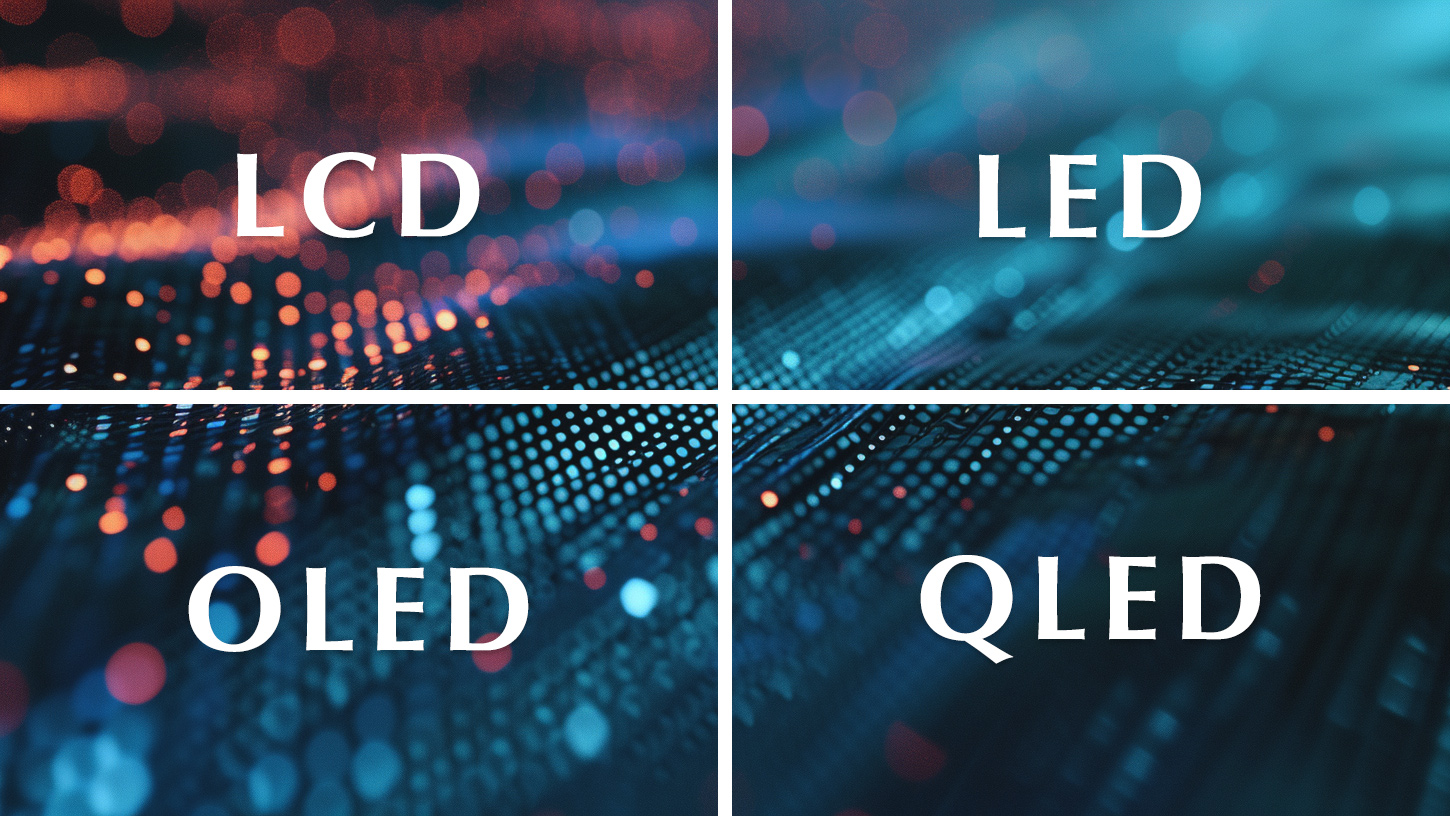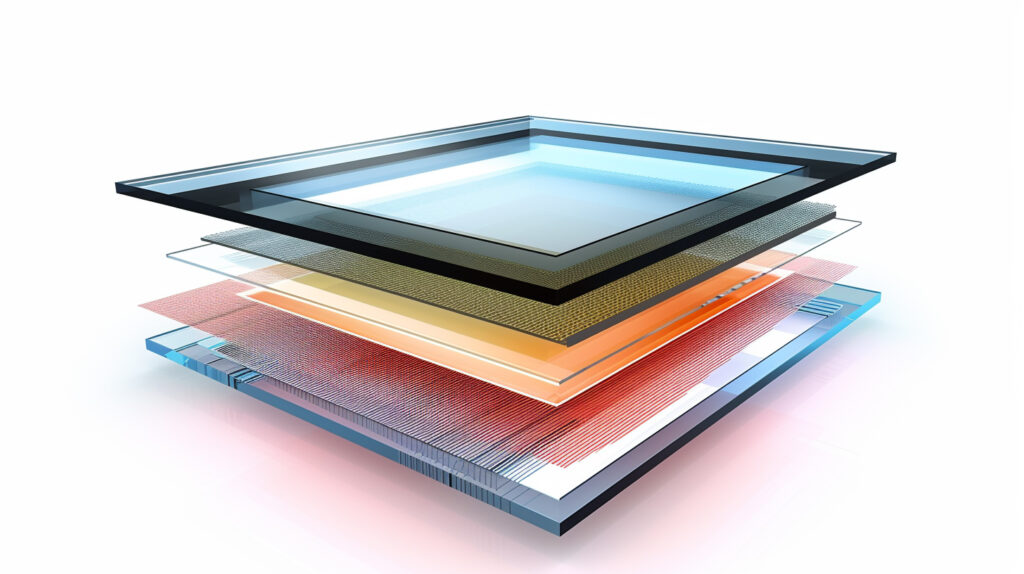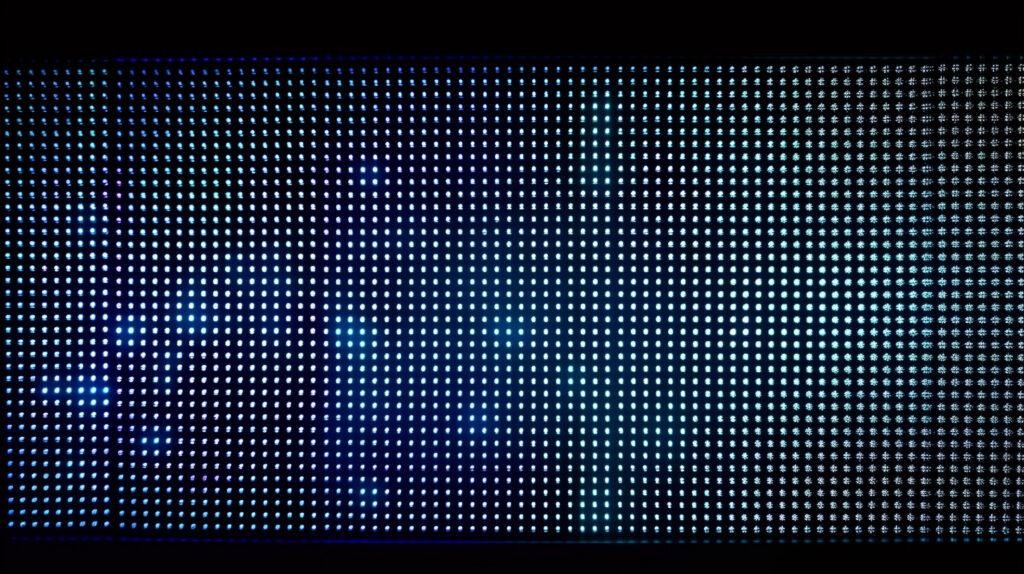LCD vs LED vs OLED vs QLED


Ever wonder why your smartphone screen pops with color, or why your TV doesn't guzzle up your entire electricity bill? Well, it's all thanks to the wizardry of screen technology. It's the unsung hero behind your binge-watching marathons and your midnight scrolling sessions.
Now, let's get our geek on and talk about the big players in the game: LCD, LED, and OLED. These aren't just random letters thrown together; they're the gatekeepers of pixels, the maestros of your display!

LCD stands for Liquid Crystal Display. Think of it as a technological sandwich. The bread? Those are polarizing filters. The filling? It's a layer of liquid crystals. And just like your favorite sandwich, it's what's in the middle that counts. These liquid crystals don't emit light by themselves; they work their magic by twisting and turning to control the light passing through them. Add a backlight into the mix, and voilà, you've got yourself an image!
Now, let's talk colors. LCDs are like chameleons; they change color by adjusting the intensity of light passing through the liquid crystals. This is where things get a bit tricky, though. While LCDs are great at bringing you vibrant colors, they've got their own set of challenges. Ever noticed how the black on your LCD screen seems more like a dark gray? That's because the backlight of the screen is always on, and true black is a tough cookie to crack when there's light peeking through.
LCDs are a bit like marathon runners when it comes to power consumption – they're in it for the long haul, not the sprint. They're pretty energy-efficient, which is why your laptop doesn't give up on you after just a couple of hours. And when it comes to battery life in portable devices, LCDs are your best bud, helping you binge-watch, work, or play without being tethered to a power outlet.
But, it's not all sunshine and rainbows. LCDs, like everything else, have their own kryptonite – longevity and durability. Ever had a screen go a bit wonky with age? Or noticed how an old calculator's numbers aren't as crisp as they used to be? That's the LCD's way of telling you it's been through a lot.
So there you have it – a sneak peek into the world of LCDs. They're the unsung heroes that light up our digital life, from smartphones to TVs. Next time you're swiping through your phone or catching up on your favorite show, give a little nod to the LCD technology working tirelessly behind the scenes. It might not be perfect, but it sure does a fantastic job at bringing the digital world to our fingertips!

LED is like the cool kid on the tech block. It stands for Light Emitting Diode, and trust me, it's as cool as it sounds. These tiny diodes are masters of light, and they don't need any backlight to strut their stuff. Each LED is a mini light source, flashing bright colors directly to your screen. And the best part? They can be super tiny, meaning your screen can pack millions of these to create stunning, vivid images.
When it comes to color, LED screens are like a box of crayons – the more, the merrier! Each tiny LED can produce a kaleidoscope of colors, bringing life to your favorite movies, games, and photos. And when LED goes for black, it goes all out. LEDs can completely shut off to give you those deep, true blacks, making your horror movie nights extra spooky.
Now, let's talk shop – efficiency and performance. LEDs are like the energy-saving heroes of the screen world. They're more power-efficient than a room full of monks meditating! This means your gadgets can last longer between charges, giving you more screen time without the guilt trip of a huge electric bill.
But hey, even superheroes have their Achilles' heel. LEDs are amazing, but they're not invincible. They can dim over time, and if one LED decides to throw in the towel, it might stand out like a sore thumb on your screen.
LED technology isn't just about lighting up screens; it's about making them smarter, more efficient, and a whole lot prettier. So, the next time you're lost in the pixels of your latest binge-watch or gaming marathon, give a little nod to the LED tech working its magic right under your fingertips. It's the bright spark that's revolutionizing the way we see, play, and interact with our digital world!

OLED stands for Organic Light Emitting Diode. “Organic” – sounds fresh, doesn’t it? Unlike its LCD cousin, OLED doesn’t need a backlight. Each pixel is a tiny, self-sufficient light source, thanks to organic compounds that glow when zapped with electricity. It’s like having millions of tiny lightbulbs, each one ready to put on a show at a moment’s notice.
When it comes to color and contrast, OLED is the maestro. Ever gazed at a screen and felt like you could reach out and touch the colors? That’s OLED for you! The secret sauce is its ability to control the light of each pixel individually. And black? OLED nails it! When it needs to show black, it simply turns off the pixels. No light leakage, just pure, deep black. The result? Contrast that’s as sharp as a tack and colors that pop like a burst of confetti!
OLED is like the cool, energy-conscious friend we all need. With no backlight to power, it’s inherently more energy-efficient, especially when displaying darker scenes. Your gadget’s battery breathes a sigh of relief, giving you more time to enjoy what you love without hunting for the nearest power outlet.
But hang on, no tech is perfect, right? OLED’s Achilles' heel is its lifespan, particularly when it comes to certain colors. Ever heard whispers about screen burn-in? That’s when an image gets a little too comfy and leaves a shadow of its presence behind. It’s not super common, but it’s OLED’s way of saying, “Hey, I need a break from this marathon.”
There you have it, the scoop on OLED! It’s the glitzy star of the display tech scene, with colors that make rainbows jealous and a knack for efficiency that’s hard to beat. Next time you’re swiping on your phone or ogling over that ultra-sleek TV, give a little nod to OLED – the technology that turns everyday viewing into a front-row seat at a spectacular show!

Imagine a tiny universe living inside your screen. That's essentially what Quantum Dots are – minuscule nanoparticles that light up like fireflies on a summer night. But these aren't your ordinary fireflies. When hit by light, these Quantum Dots glow, emitting colors that are so vivid and pure, they make rainbows jealous.
Color is where QLEDs really strut their stuff. These screens don't just display colors; they make them sing. The secret? Each quantum dot emits a specific color depending on its size. Bigger dots groove to the reds, while the smaller ones vibe with the blues. The result? A color spectrum that's wider and more dazzling than the finale of a fireworks show.
But wait, there's more! QLEDs aren't just about popping colors; they're also about precision. Blacks are deeper, whites are brighter, and every shade in between is more nuanced. It's like going from a box of basic crayons to a deluxe artist's palette.
QLEDs aren't just a pretty face; they've got the brains to match. When it comes to energy efficiency, they're leading the pack. They're like the hybrid cars of the screen world – high performance, but mindful of energy. That means you can binge-watch, game, or work without feeling like you're power-hungry.
And longevity? QLEDs are playing the long game. These screens are like the tortoises in the tech race, built to last and resist the burn-in that can make a screen feel old before its time. So, your investment isn't just for the here and now; it's for many brilliant views ahead.
So, there you have it – a journey into the vibrant world of QLED. These screens are more than just tech; they're a window into a world where colors burst, energy efficiency is key, and longevity is a given. Next time you're in front of a QLED screen, remember the quantum dots working their microscopic magic, transforming light into a spectacle of color. It's not just an advancement; it's a quantum leap!
LCD vs. LED vs. OLED vs. QLED
Hey there, tech enthusiasts and screen savants! Today, we’re diving into the dazzling world of displays. We've got LCD, LED, OLED, and QLED in the ring, ready for a head-to-head showdown. Let's break it down, shall we?
LCD (Liquid Crystal Display): The Old Reliable
LCDs are like that trusty old friend who's been around forever. They use liquid crystals teamed up with a backlight to light up your life, or, well, your screen. They're energy-efficient and give you decent color reproduction. But when it comes to showing true blacks, LCDs can be a bit of a party pooper. They're not perfect, but hey, they get the job done.
LED (Light Emitting Diode): The Bright Spark
LEDs are essentially the cool cousin of LCDs. They also use liquid crystals, but they've got LEDs as a backlight, which makes them brighter and more energy-efficient. Colors pop more, and the contrast is better than LCDs. It's like going from a cozy bonfire to a full-blown fireworks show.
OLED (Organic Light Emitting Diode): The Premium Performer
OLEDs? Now we're talking high-end. Each pixel is its own little light source, which means they can turn off completely to give you those deep, dreamy blacks. Colors are vibrant, contrast is top-notch, and viewing angles are so wide you could share your screen with a crowd (you know, if you're into that). They're like the VIPs of screens, but they do tend to be a bit more high-maintenance and pricey.
QLED (Quantum Dot LED): The Color Maestro
Enter QLED, the latest contender. These screens are all about color. Quantum dots, tiny nano-particles, light up to give you a spectrum of hues that's as rich as a billionaire. They're brighter than a sunny day and great for well-lit rooms. Think of them as the color wizards, casting spells to enchant your viewing experience.
Now, let's line them up for a quick smackdown:
| Feature | LCD | LED | OLED | QLED |
|---|---|---|---|---|
| Color Accuracy | Good | Better | Best | Best |
| Brightness (nits) | 300 - 500 | 350 - 700 | 200 - 600 (Peak 800+ for HDR) | 700 - 2000 (Peak 4000+ for HDR) |
| Contrast | Fair | Good | Exceptional | Excellent |
| Black Levels | Not the Best | Better | Perfect | Very Good |
| Viewing Angles | Limited | Good | Excellent | Very Good |
| Color Depth (bits) | 6 - 8 | 8 - 10 | 10 - 12 | 10 - 12 |
| Lifespan (hours) | 30,000 - 60,000 | 50,000 - 100,000 | 20,000 - 100,000 | 30,000 - 100,000 |
| Power Consumption (W) | Low (varies by size) | Lower (varies by size) | Low (varies greatly with content) | Moderate (varies by size and brightness) |
| Price | $ (Affordable) | $$ (Mid-range) | $$$ (Premium) | $$ - $$$ (Varies) |
LCD vs LED vs OLED vs QLED
In the end, it's all about what you want your screen to do for you. Need something easy on the wallet? Go LCD or LED. Craving that cinematic color and contrast? OLED might be your jam. If color richness paired with brightness is your thing, QLED has got your